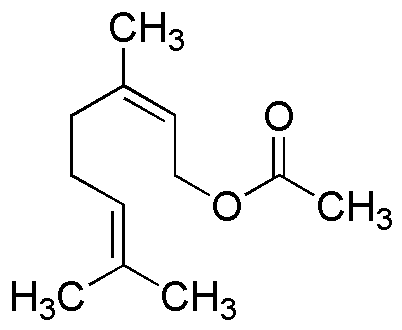Neryl acetate is widely utilized in research focused on:
- Fragrance Industry: Commonly used in perfumes and scented products, neryl acetate provides a fresh, floral aroma, enhancing the sensory experience of personal care items.
- Flavoring Agent: In the food industry, it serves as a flavoring agent, imparting fruity notes to various food products, making it popular in confectionery and beverages.
- Cosmetics: Its pleasant scent and skin-friendly properties make it a favored ingredient in cosmetics, contributing to formulations for lotions, creams, and other beauty products.
- Aromatherapy: Neryl acetate is used in essential oil blends for its calming effects, making it a popular choice in aromatherapy products aimed at relaxation and stress relief.
- Research Applications: In scientific studies, it is often used as a model compound to investigate the properties of esters and their reactions, aiding in the development of new synthetic methods.
General Information
Properties
Safety and Regulations
Applications
Neryl acetate is widely utilized in research focused on:
- Fragrance Industry: Commonly used in perfumes and scented products, neryl acetate provides a fresh, floral aroma, enhancing the sensory experience of personal care items.
- Flavoring Agent: In the food industry, it serves as a flavoring agent, imparting fruity notes to various food products, making it popular in confectionery and beverages.
- Cosmetics: Its pleasant scent and skin-friendly properties make it a favored ingredient in cosmetics, contributing to formulations for lotions, creams, and other beauty products.
- Aromatherapy: Neryl acetate is used in essential oil blends for its calming effects, making it a popular choice in aromatherapy products aimed at relaxation and stress relief.
- Research Applications: In scientific studies, it is often used as a model compound to investigate the properties of esters and their reactions, aiding in the development of new synthetic methods.
Documents
Safety Data Sheets (SDS)
The SDS provides comprehensive safety information on handling, storage, and disposal of the product.
Product Specification (PS)
The PS provides a comprehensive breakdown of the product’s properties, including chemical composition, physical state, purity, and storage requirements. It also details acceptable quality ranges and the product's intended applications.
Certificates of Analysis (COA)
Search for Certificates of Analysis (COA) by entering the products Lot Number. Lot and Batch Numbers can be found on a product’s label following the words ‘Lot’ or ‘Batch’.
*Catalog Number
*Lot Number
Certificates Of Origin (COO)
This COO confirms the country where the product was manufactured, and also details the materials and components used in it and whether it is derived from natural, synthetic, or other specific sources. This certificate may be required for customs, trade, and regulatory compliance.
*Catalog Number
*Lot Number
Safety Data Sheets (SDS)
The SDS provides comprehensive safety information on handling, storage, and disposal of the product.
DownloadProduct Specification (PS)
The PS provides a comprehensive breakdown of the product’s properties, including chemical composition, physical state, purity, and storage requirements. It also details acceptable quality ranges and the product's intended applications.
DownloadCertificates of Analysis (COA)
Search for Certificates of Analysis (COA) by entering the products Lot Number. Lot and Batch Numbers can be found on a product’s label following the words ‘Lot’ or ‘Batch’.
*Catalog Number
*Lot Number
Certificates Of Origin (COO)
This COO confirms the country where the product was manufactured, and also details the materials and components used in it and whether it is derived from natural, synthetic, or other specific sources. This certificate may be required for customs, trade, and regulatory compliance.


